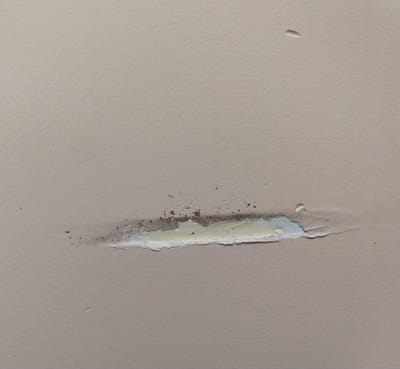
Nicks that damage the drywall paper
Drywall paper helps protect the drywall surface, giving stability to the underlying gypsum. It also provides a smooth layer for painting. If a dent or nick has broken through the drywall paper, the integrity of the drywall in that area could be compromised. If the damage breaks through the drywall paper, you will need to use paper drywall tape for the repair. How do you know when this is necessary?
 In general, if the damage is simply a small slit one inch or shorter in length, you will not need to use paper drywall tape over the repair. If however, the nick exposes more than one inch² of gypsum material, you should use paper drywall tape to add strength to the repair before floating it smooth. The paper drywall tape acts like a bandage, protecting the gypsum and surrounding paper from moisture.
In general, if the damage is simply a small slit one inch or shorter in length, you will not need to use paper drywall tape over the repair. If however, the nick exposes more than one inch² of gypsum material, you should use paper drywall tape to add strength to the repair before floating it smooth. The paper drywall tape acts like a bandage, protecting the gypsum and surrounding paper from moisture.
What could happen if you don't use paper tape?
Nicks and dents that break the drywall paper are susceptible to moisture damage. When floating over a dent repair with drywall mud or painting the patch using water-based paint, moisture from the drywall mud or paint will seep into the underlying gypsum or surrounding drywall paper. This can cause the surrounding drywall paper to bubble up and separate from the underlying gypsum.
Bubbling drywall paper creates an extremely frustrating problem. First of all, bubbles in drywall paper do not always become evident until sometime after you leave the repair. Usually, a half hour or so after you apply finish coat mud to damaged drywall paper, it begins to separate from the gypsum and causes bubbling. Also, successive repairs with additional layers of drywall mud can lead to more bubbling and further damage. It is best to avoid bubbling drywall paper in the first place so you don't have to fix it.
In addition to concerns about moisture damage, nicks or dents that break the drywall paper and expose large sections of gypsum reduces the integrity of the drywall. By using drywall paper tape to reinforce the patch, you can create a smooth and strong repair
Because of these issues, it is recommended that whenever you have more than very minor damage to the drywall paper you use paper drywall tape to strengthen the repair. The following steps outline what should be done when you are repairing drywall dents, scratches, and nicks that have broken through the drywall paper.
Step 1 - Create an indentation
Using the butt end of a six-inch drywall knife, gently press the gypsum on and around the damaged area to create a slight indentation. Make sure to indent not only the damaged gypsum but also some of the surrounding drywall paper.
Step 2 - Check the indentation
Using the metal blade of a six-inch drywall knife as a straightedge, check that the entire damaged area is slightly recessed relative to the surrounding drywall. If any section of the damaged drywall hits the knife, you need to indent the paper or gypsum deeper.
Step 3 - Tape the damage using paper drywall tape
Using all purpose mud, or quick set drywall mud spread a thin layer of mud across the damaged section. Place enough drywall tape to overlap the existing drywall paper that surrounds the damage.
Press the drywall tape firmly using a six-inch drywall knife to squeeze out excess drywall mud. Smooth out any excess drywall mud from around the drywall paper tape. If you are using all-purpose drywall mud, allow it dry for approximately 24 hours. Quick set drywall mud can be re-coated within minutes.
Step 4 - Float out the repair with thin layers of drywall mud
Using light weight all purpose drywall mud spread a thin layer of mud over the patch with an eight-inch drywall knife. Take care not to add so much mud that the patch becomes humped or convex.
Continue adding additional thin layers of drywall mud over the patch using a ten-inch drywall knife. Allow each layer to dry for approximately 24 hours before adding more drywall mud. Usually, three or four coats of mud are enough for a smooth and flat repair.
Alternatively, you can use quick set drywall mud, also known as hot mud, to float out the patch. If hot mud is used, it is recommended that you use a lightweight-all-purpose joint compound for the final coat. This helps to ensure that there are no pockmarks and makes the finished product easier to sand.
Step 5 - Sand lightly
Using 150-grit sandpaper, or a medium sanding sponge, sand the patch lightly to smooth out any rough edges and remove tool marks. Take a bright light (halogen work lights are best) and shine it across the patch to check for any uneven areas. If there is a tool mark or divot in the mud, the bright light will create a shadow that shows you what needs to be fixed.
If while sanding, you notice that any remaining tool marks or pock marks cannot be removed, you may need to touch up the patch with a thin layer of drywall mud. The touched-up areas should be allowed to dry and then finished with a light sanding.
Step 6 - Re-texture the drywall patch
Texturing a drywall patch so that it matches the surrounding texture requires skill and patience. Matching drywall texture is one of the more challenging parts of drywall finishing. Keep in mind that the viscosity of the texture mud used is the most important factor in how well a texture matches. You can read some more suggestions about matching drywall texture in this article.
Conclusion
Minor drywall damage such as nicks, dents, and scratches that break through the drywall paper surface and compromise the underlying gypsum must be fixed using drywall paper. When using drywall paper to reinforce a drywall repair, either all-purpose drywall mud or quick set drywall mud must be used. Drywall spackle is not strong enough for this type of repair. If the damage breaks through the drywall entirely and creates a hole, you must use a different method from that described above.
